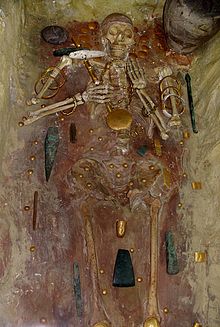From Wikipedia, the free encyclopedia
(Redirected from Gold of Varna)
|
Part of a series on the
|
|---|
| History of Bulgaria |
 |
|
| Main category |
Contents
Discovery and excavation
A total of 294 graves have been found in the necropolis,[2] many containing sophisticated examples of metallurgy (gold and copper), pottery (about 600 pieces, including gold-painted ones), high-quality flint and obsidian blades, beads, and shells.
Chronology
The graves have been dated to 4560-4450 BC by radiocarbon dating in 2006 [2] and belong to the Eneolithic Varna culture, which is the local variant of the KGKVI.Burial rites
The findings showed that the Varna culture had trade relations with distant lands (possibly including the lower Volga and the Cyclades), perhaps exporting metal goods and salt from the Provadiya rock salt mine [2]. The copper ore used in the artifacts originated from a Sredna Gora mine near Stara Zagora, and Mediterranean Spondylus shells found in the graves may have served as primitive currency.
The culture had sophisticated religious beliefs about afterlife and developed hierarchical status differences: it offers the oldest known burial evidence of an elite male (the end of the fifth millennium BC is the time that Marija Gimbutas claims the transition to male dominance began in Europe). The high status male buried with the most remarkable amount of gold held a war adze or mace and wore a gold penis sheath. The bull-shaped gold platelets perhaps also venerated virility, instinct force, and warfare. Gimbutas holds that the artifacts were made largely by local craftspeople.
Historical impact
According to M. Gimbutas (1991), "The discontinuity of the Varna, Karanovo, Vinča and Lengyel cultures in their main territories and the large scale population shifts to the north and northwest are indirect evidence of a catastrophe of such proportions that cannot be explained by possible climatic change, land exhaustion, or epidemics (for which there is no evidence in the second half of the 5th millennium B.C.). Direct evidence of the incursion of horse-riding warriors is found, not only in single burials of males under barrows, but in the emergence of a whole complex of Kurgan cultural traits."According to J. Chapman (2005), "Once upon a time, not so very long ago, it was widely accepted that steppe nomads from the North Pontic zone invaded the Balkans, putting an end to the Climax Copper Age society that produced the apogee of tell living, autonomous copper metallurgy and, as the grandest climax, the Varna cemetery with its stunning early goldwork. Now the boot is very much on the other foot and it is the Varna complex and its associated communities that are held responsible for stimulating the onset of prestige goods-dominated steppe mortuary practice following the expansion of farming."
Among the metallic (gold and copper) and non-metallic (minerals, rocks, pottery, pigments, biofacts) artifacts in the graves from the Varna Chalcolithic site are numerous beads of a chalcedony (carnelian) and agate composition. Three main morphological types of beads are described: type 1 – elongated barrel-shaped; type 2 – elongated with trapezohedral facets; type 3 – short cylindrical (Kostov, 2007; Kostov, Pelevina, 2008). The carnelian and related beads of type 2 have a “constant” number of 32 facets – 16+16 on both sides on the elongation of the bead, which is considered probably the earliest in Chalcolithic times complex type of faceting on such a hard mineral (hardness of chalcedony is 6.5-7 on the Mohs scale). In the hole of a single carnelian bead was found a gold mini-cylinder (~2x2 mm). The gold artifacts from the Varna Chalcolithic necropolis are assumed to be the “oldest gold of mankind” according to their total volume and quantity. Analysis of the measured weight of the different types of gold artеfacts (beads, appliqués, rings, bracelets, pectorals and diadems) revealed a weight system with at least two minimal weight units of ~0.14 and ~0.40 g among both mineral and gold beads (Kostov, 2004; 2007). The second one (=2 carats) was suggested as a basic “Chalcolithic unit” with the name van (from the first letters of Varna necropolis).
In 2009, logician H. Smolenov suggested that the Varna culture people had achieved certain advanced mathematical knowledge testified by the artifacts from the necropolis, some of which might have been used for navigation purposes apart from their possible sacral function.
Museum exhibitions
The artifacts can be seen at the Varna Archaeological Museum and at the National Historical Museum in Sofia. In 2006, some gold objects were included in a major and broadly advertised national exhibition of antique gold treasures in both Sofia and Varna.The gold of Varna started touring the world in 1973; it was included in "The Gold of the Thracian Horseman" national exhibition, shown at many of the world's leading museums and exhibition venues in the 1970s. In 1982, it was exhibited for 7 months in Japan as "The Oldest Gold in the World - The First European Civilization" with massive publicity, including two full length TV documentaries. In the 1980s and 1990s it was also shown in Canada, Germany, France, Italy, and Israel, among others, and featured in a cover story by the National Geographic Magazine.
Varna necropolis artifacts were shown for the first time in the United States in 1998 and 1999 as part of a major Bulgarian archaeological exhibition, Thracians' Riches: Treasures from Bulgaria. In 2009-2010, several artifacts were shown at the New York University Institute for the Study of the Ancient World in a joint Romanian-Bulgarian-Moldovan exhibition entitled The Lost World of Old Europe: The Danube Valley, 5000-3500 BC.[3][4] [5]


No comments:
Post a Comment